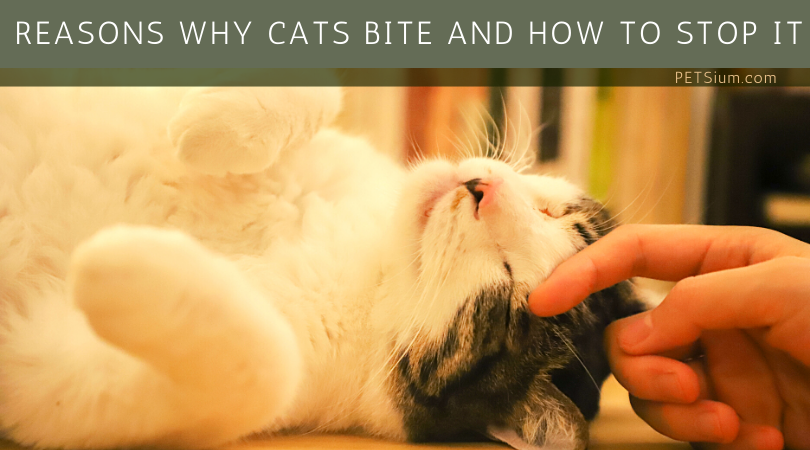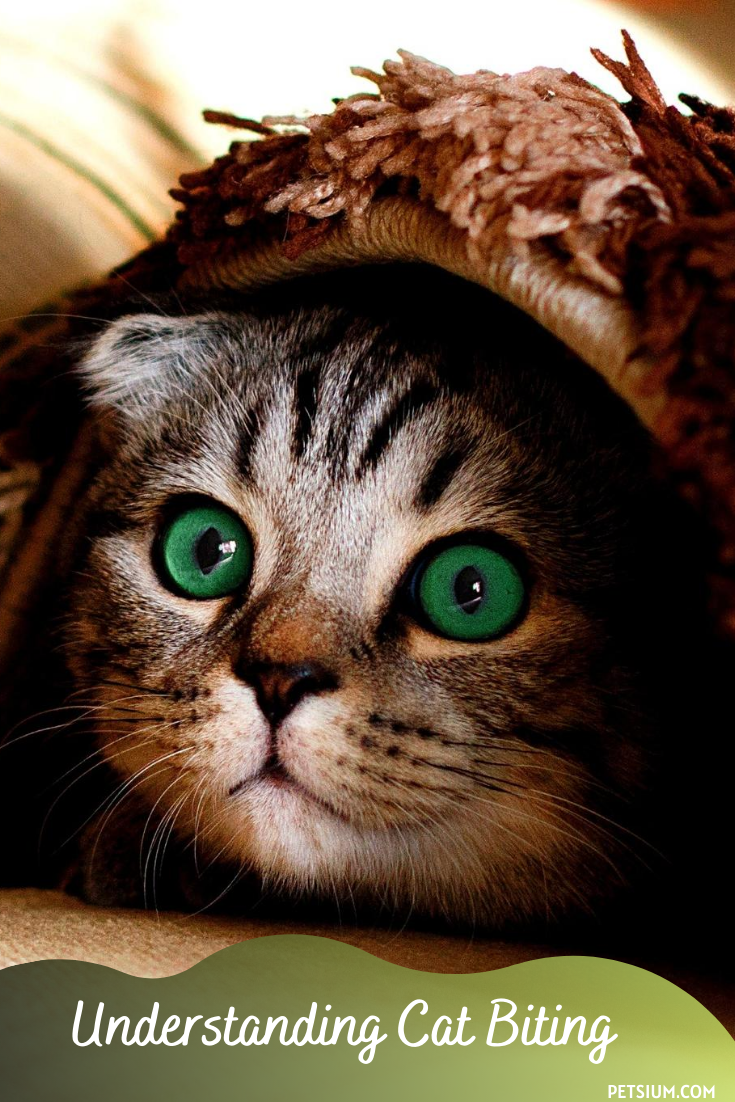Cat Biting is a problem that cat owners may face at some point. It is very important to deal with this problem immediately. The reasons for cat biting can be many.
One of the common reasons of cat biting is fear. Find out if your cat is afraid of something, or if it is being irritated by something or someone. Cat biting while playing is natural and so you need to be careful as this is when the cat releases the energy. However if your kitty is biting you lightly, he or she is actually showing love.

Cat biting may also be a result of the cat being in pain. It he or she starts biting for no apparent reason, it is important to have a vet check your cat.
You will have to understand the difference between your cat nipping you and biting you. If the biting draws out blood, it is very important that you take immediate attention to stop and break the habit. It is important to find out what triggers the problem and then try to stop it.
This rather undesirable behavior may strike at any time with any cat when they feel threatened or unable to express their discontent with their current circumstances. Many times an unexpected intolerance to the amount of petting or stroking that a cat may allow is the cause for a quick nip.
Post Navigation
Why Do Cats Bite
Have you ever settled into bed or nestled into the couch and who should appear but your precious cat? She situates herself within hand’s reach and you start to stroke her addictingly soft fur. She is appreciative, emitting a rhythmic purr. All of sudden, after a stretch of time has passed; your cat suddenly bites your hand.
You are puzzled as to why she would react in such a way. For some cats, this is their means of communicating that they have had enough petting. This is not always the case – other felines remove themselves from the action or slowly wander away.
Some owners are appalled the first time their cat has bitten them and want to make sure the act doesn’t occur again. In most cases, there are signs that a cat gives to warn of an impending nip or bite, but often an owner is unaware of what each signal means. For instance, when the tail of a cat begins to twitch with a rolling flick motion, a bite may soon follow.
The ears of the cat are also quite telling. When they begin to turn towards the back or become flattened against the head, she is letting out a warning. If your cat appears restless, stiffens her body, or begins to stare at your hand, these are also signs that a sharp attack may occur.
When any of the above signs presents themselves during a session of stroking, it is suggested to stop the petting and allow your cat to remain positioned beside you or on your lap, jump down, or walk away when they feel ready. Whatever they decide to do, biting doesn’t have to become one of the options.
If your cat bites you, it never pays to punish your pet for the action. Not only does it not work, but also many cats start to equate punishment with your presence and don’t even consider biting as a bad behavior. As hard as it may seem, but if you have missed the cue that a bite is coming, the proper way to handle the situation is to not pull the hand away or push the cat aside. Freezing is the best solution because often, a cat will not puncture the skin if they feel their message was received in full. Their aim is to stop you from petting them, not to cause intentional harm.
Some cats revert to aggression for a many number of reasons. They may have inherited the behavior through genetics or learned the conduct as a kitten. Owners who allow their kittens to chew on their hand during play have learned that it is OK to respond in this manner when they have “had enough” of the stroking and warning signals have been ignored.
Some owners have found ways to make petting a more enjoyable activity for their cat by using treats as incentives to encourage a lengthening of their tolerance. Overall, avoiding a cat bite means paying attention to the signs and signals associated with your feline.
The Dangers of Cat Bites to Humans
To most pet lovers, there can be nothing sweeter than the feel of a loving cat nuzzling your arms. This is the reason why many would simply ignore being bitten by their feline companion and chalk it up as a moral lesson. However, the infections that could occur from cat bites to humans can potentially lead to something very serious if left untreated (or even if the wound was simply not treated the right way).
This is often compounded by the fact that most cat bite wounds have a tendency to heal very quickly, which often results in the bacteria remaining in the scar tissue—a nesting ground for infection. Below are some of the consequences that could occur from a cat bite, the signs of infection and how to avoid it.
Pasteurella is a kind of bacteria that is commonly found in the mouth of a cat. If your bite gets infected with this type of bacteria, you could contract pasteurellosis, one of the most common yet dangerous outcomes of cat bites to humans. The signs become apparent around twelve hours after the bite (a lot of swelling, and a lot of pain).
Once you notice the signs, it would be best to seek medical attention immediately, as pasteurellosis has a tendency to spread and can cause permanent damage if left untreated. Aside from this, cat bites to humans can cause staphylococcal infections that produce a wide range of side-effects such as pneumonia, or even blood poisoning.
Streptococcal infections on the other hand can cause kidney failure. The immediate signs of the three infections are very similar, and all three require medical attention.
In order to stop any of this from happening in the first place, you must understand that cat bites to humans can be dangerous, and you must never underestimate it. Do not provoke your cat, and stay away from stray cats that look agitated.
How to Deal With Cat Biting
You may have encouraged the cat biting behavior unknowingly. Having a spray bottle proves handy when playing with him/her and you can spray lightly right on his face if he/she does bite you. Getting lot of cat toys for him/her to release the energy is very important so that he/she can wrestle and play with them. A toy ball that bounces well is a toy that your kitty will love.
Giving enough attention to your cat is important to prevent any negative behavior. Cat biting is a serious problem that you will need to stop immediately as it can inflict harm and pain to you, relatives or family members. However it is extremely important not to over react when the cat bites you.

Cat Biting Training Tips 1
Cats can use biting as a means of defense. If you hurt your cat, whether intentionally or accidentally, the cat is biting to show you that he was hurt. If this happens, don’t clap or spray water on him, just say “no”.
Cat Biting Training Tip 2
The instance your cat moves to bite you, firmly grab the scruff of his neck and force his head down, and so “no” just like in cat biting training tip 1. Just make sure that you’re not hurting your cat, just stop him for that moment.
Cat Biting Training Tip 3
If your cat continuous to bite, tap your cat on the top of his nose. This does not hurt your cat but it annoys him.This usually really works!
Cat Biting Training Tip 4
Make sure that you do not cuddle your cat after you have disciplined him/her. This will confuse your cat and give it mixed feelings, so next time it will bite you again.
Cat biting is another one of the most common behavior issues that people have with cats. Aggressiveness comes naturally to them but if we are to live together in harmony, we must employ ways to curb this instinctual behavior.
Cats bite for two primary reasons: over stimulation and play aggression.
Stop Cat Biting Due To Over Stimulation
Keep this in mind: If you don’t exert dominance, your cat will continuously battle you for it. The reason the biting occurs when you are petting your cat is because your cat is attempting to basically take control of your relationship.
Each time your cat tries to bite, even if in play, you must loudly and firmly command “stop it!” or “no!” After a while, your cat will understand the repercussions of aggressive behavior and stop biting.
A cat’s mouth contains bacteria that can cause infection. Their sharp teeth are designed to puncture the skin and can cause tissue damage. A serious bite can send you to the doctor so it is important that you watch for the warning signs that your cat about to bite. If you are consistent with the training, eventually your cat will learn not to bite but in the meantime you should be practical and learn the signs of a pending biting attack and protect yourself.
These signals can include tail twitching and body tensing. If this happens, you may want to stop petting your cat or cease whatever behavior is provoking your cat.
Stop Cat Biting Due To Play Aggression
When your cat exhibits biting or aggressive behavior, roll it on its back and gently hold him or her immobile until he or she calms down. While you do that, use verbal cues to indication that the behavior is not to be tolerated. I used a very commanding, “stop it” when my kittens were being trained not to bite. Placing the kitten on it’s back is putting it in a very vulnerable position. By doing this, you are also teaching your kitten to trust and respect you.
NEVER intentionally hurt your kitten or cat. This will destroy trust and your relationship will be continuously problematic. You must exercise restraint and compassion while taking your rightful place as the Alpha in your domestic pride.
Your goal is to essentially take the roll of firm, yet loving, parent in your cat’s life. If your cat learns to see you in that roll, your bond will be unbreakable and you will have cats that people with unruly cats truly envy.
How to Stop Cat Biting, Continued…
As we discussed above, kittens engage in naturally aggressive play that includes biting. When your kittens are cute and little. it is tempting to take your hands, wrestle with them, and encourage them to “attack”. This kind of play must be avoided if you want to a cat that doesn’t bite. At that point, if your cat is still seeing your hand as something to attack, you will literally feel the pain of that mistake for a long time!
Use Toys to Stop Cat Biting
It is imperative that you train your cat not to see your hand as a plaything. To this end, cat toys are essential. It is crucial when playing with your kitten to put the focus on a toy, rather than your hand. A fishing-pole toy is extremely helpful with this because it puts a safe distance between your hands and your cat’s fangs.
It also helps teach your cat what is acceptable to bite. You don’t have to deny yourself the joy of playing with and enjoying your kitten or cat… you just have to change the tactics of play.
Another thing to remember in the “stop cat biting” training process is that when your kitten or cat does cross the line and get too aggressive, end the game immediately. A stern “no” or “stop it” helps identify what behaviors are discouraged. Be consistent and your pet will catch on.





Leave a Reply